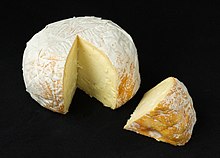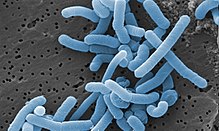User:R KUSHALA/sandbox
Cheese production[edit]

Cheese making has been being practiced for nearly about 4000 years now. Cheese is made from curdling of milk. It requires an enzyme called rennet, and bacteria. It is a substance made of coagulated protein called casein, and fat. Curdling of milk gives rise to two parts, cheese and whey. It is one of the extensively used food product throughout the globe.[1] There are thousands of varieties of cheese based on their colour, their place of manufacture etc.
History[edit]
It is said that thousands of years ago, a man who was carrying milk in a pouch made of goats stomach, walking through the desserts opened the bag to drink some of the milk after a few days and found that the milk had converted and separated into soft substance which is now called cheese and whey. It originated in Asia and then came to the Europe and then to the United States, studies have shown that America uses the highest amount of cheese, an average American consume 37.1 pounds of cheese per year.[2]
Production of cheese[edit]

The necessary ingredients required for cheese production is milk, acid, enzyme and bacteria.It is very important for the milk to have certain characteristics to make it suitable for cheese making it should have sufficient fatty acid, casein proteins and the presence of lactose makes it suitable for the growth of lactic acid bacterium, the property of casein to withstand high temperature and it not being water soluble makes the separation of cheese and whey easy. The pH of the milk should be 6.4 but on the action of microorganisms (during fermentation) like LAB the pH reduces to 4. The water availability of milk should be minimum for the growth of the organisms and it can be less based on the presence of the dissolved molecules. The oxygen requirements varies based on the organism acting if LAB is used since it is anaerobic in nature, oxygen is not required, but the milk contains dissolved oxygen which will be consumed during the growth of the microorganism.[3]
The steps involved in the process of cheese making are as follows:
1.Standardisation of milk: It is by optimising the proper protein to fat ratio, and the ratio differs based on the kind of cheese required if a high moisture cheese is required then the ratio of protein to fat will be less. Optimising the ratio provides better yield. Standardisation can be done by addition of concentrated non-fat milk, addition of skim milk and by removing cream.
2. Pasteurisation: There are four kinds:
- No heat treatment would give rise to raw milk cheese it has more flavour, which is to be stored for 60 days.
- Heating at 63-65°C to be stored for a short time which makes the milk positive of phosphatase this is to avoid raw milk spoiling this has to be pasteurised before cheese making.
- Pasteurisation, 63°C, 30 min which is the safest alternative but it doesn’t fully flavour during ripening. It should be noted that over heating can cause denature of whey proteins which inturn lowers the casein protein
- Heat treat 55-65°C, 16s sub-pasturisation is applied which kills pathogen but allows the bacteria to thrive which will allow the flavouring during ripening. additives like calcium chloride and nitrates can be added.
3. Cooling: The milk is cooled or heated 90F (32°C)to bring to the temperature needed for the starter bacteria to grow. If it is raw milk then the milk should be heated to 90F (32°C).
4. Culturing: Starter culture are those which initiate the production of acid in the milk this is due to the conversion of sugar in the milk to acid leading to decrease in the pH therefore making it not suitable for the entry of pathogens. It also helps in providing flavour by ripening. It is added at 90F(32°C) and held for 30 minutes. The cultures are made by the process of genetic engineering.[4]
5. Coagulation: The enzyme rennet is added, it acts on the milk proteins to form curd, rennet has the enzyme chymosin which converts casein to para k casien and glycomacropeptide, it takes about 30 minutes for the separation of the milk to take place.
6. Cutting the curd and heating: The curd is allowed to ferment until it reaches pH 6.4 and it is cut and heated to 100F, this helps in the separation of cheese and whey.
7. Draining: The water present can harm the cheese and therefore is removed using partial dehydration and whey is drained from the mixture. And the curd forms mat.
8. Cheddaring: The curd in the mat is cut into pieces and is placed on one another the weight of one another causes the remaining moisture and whey to leave the curd and the fermentation continues until the pH of 5.1-5.5 is reached.[5]
9. Addition of salt or brine: The cut loaves of cheese are put back into the vat by sprinkling 0.63% of salt, for cheese like mozzarella the loaves are put back into the vat into the brie (salt solution).[6]
10. Blocks of cheese: The loaves are placed in cheese hoops and pressed into blocks to form cheese.
11. Storage and age: The cheese blocks are placed in muslin cloth or other bags and are stored and left to age based on their variety. 12. Packaging: It can be packed into air tight bags.
Microbes used in cheese[edit]
Microorganisms such as bacteria, mols, yeasts and other organisms are used for the production of cheese, theses microbes help in the process of fermentation and provides flavour to the cheese. Some of the types of microbes used are given below:

1.Lactic acid bacteria: This is the most used bacteria in the process of cheese making. This is mainly used due to its ability to convert lactose to lactic acid, it also acidifies the milk and is referred to as starter culture. Examples used are lactococci, streptococci, lactobacilli.
2. Adjunct cultures: These are the microbes added to not for the production of lactic acid but for flavouring of the cheese, example lactobacillus helveticus, which gives the cheese a pleasant sweet taste and it also promotes the growth of tyrosine crystals.
3. Non-starter LAB: These microbes are already present in the milk and they start developing during the process of cheese making as the starter microbes deplete. These arise during the ripening. Examples are lactobacillus casei ssp. And lactobacillus planetarium.
4. Eye formers: Some cheese like the Swiss which has holes(eye) in them are formed due to the addition of a particular bacteria called Propionibacterium freudenreichii, this organism converts lactic acid into carbon dioxide, this causes the formation of eye.[7]
5. Mold: There are two main types blue and white:
- White mold: This is produced with the help of Penicillium camemberti , it causes a nice white lawn on the cheese, it is responsible for the characteristic aroma associated with this white mold cheese.

- Blue mold: The organism Penicillium roquefortiand Penicillium glaucum are responsible for pigments which cause the blue color of the cheese and they also provide a unique flavour, these are live organisms which require oxygen to survive therefore blue cheese is not vacuum packed.
6. Yeast: It is mostly used in folded or surface ripened cheese, it plays an important part in the ageing process.
Types of cheese[edit]
Based on the manufacturing of cheese, it is broadly classified as acid cheese and rennet cheese and also there is natural and processed cheese. In acid cheese, acid is added to the milk for the coagulation of the protein, in rennet cheese, the enzyme rennet is added to the milk for coagulation. The milk used can be pasteurised or raw, based on the variation in the process of cheese production, cheese can be classified into 8 different types.
- Blue (ex: Danish blue)
- Pasta filata (ex: string cheese).
- Hard(ex: provolone).
- Semihard (ex: Gruyere).
- Processed (ex: Colby).
- Semisoft (ex: Roquefort).
- Soft and fresh (ex: ricotta).
- Soft and ripened (ex: Truffle Tremor).[8]
Advantages and Disadvantages[edit]
Advantages •The presence of calcium can help lower the blood pressure by consumption of low sodium cheese. •The antioxidants such as glutathione prevents age-related neurodegeneration. •It boosts the growth of gut microbes and has positive effect on blood cholesterol levels. Disadvantages •Consumption of high sodium causes high blood pressure. •High intake of saturated fats can lead to increased risk of diabetes, obesity or cardiovascular diseases.[9]
Reference[edit]
- ^ https://www.usdairy.com/news-articles/what-is-cheese
- ^ https://www.volpifoods.com/history-of-fermentation/
- ^ https://www.uoguelph.ca/foodscience/book-page/cheese-making-technology-ebook
- ^ https://www.thecourtyarddairy.co.uk/blog/making-ageing-cheese/what-is-starter-culture-for-cheese-and-what-does-it-do/
- ^ http://milkfacts.info/Milk%20Processing/Literature%20Related%20to%20Milk%20Processing.htm#Fox2004
- ^ https://www.slideshare.net/sajidali351/fermentation-of-cheese-1
- ^ https://www.cheesescience.org/microbes.html
- ^ https://www.everydayhealth.com/diet-nutrition/diet/cheese-health-benefits-risks-types-top-sellers-more/
- ^ https://www.medicalnewstoday.com/articles/299147#when-is-cheese-bad-for-you

